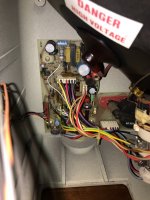Robuck
Experienced Member
Hello,
My name is Mark, and I just bought a beautiful Northstar Advantage from ebay. It was advertised as not working, and of course it doesn't. The only thing it does do is beep when I switch it on. I can hear the fan running, and the CRT screen makes the high pitched scream. Sometimes when I press enter one of the floppy drives lights up. I tried reseating the processor, but I'm not sure what I should do next. I've seen a ton of videos about restoring old PC's, and I would consider myself somewhat knowledgable about vintage computers. The only problem is that I'm not at all experienced with actually fixing them. Is there a checklist of things I should be troubleshooting? My goal here is to just get the "LOAD SYSTEM" prompt on the screen. The floppy drives are going to be a whole other nightmare. Any info would be greatly appreciated! I can provide pictures if needed.
My name is Mark, and I just bought a beautiful Northstar Advantage from ebay. It was advertised as not working, and of course it doesn't. The only thing it does do is beep when I switch it on. I can hear the fan running, and the CRT screen makes the high pitched scream. Sometimes when I press enter one of the floppy drives lights up. I tried reseating the processor, but I'm not sure what I should do next. I've seen a ton of videos about restoring old PC's, and I would consider myself somewhat knowledgable about vintage computers. The only problem is that I'm not at all experienced with actually fixing them. Is there a checklist of things I should be troubleshooting? My goal here is to just get the "LOAD SYSTEM" prompt on the screen. The floppy drives are going to be a whole other nightmare. Any info would be greatly appreciated! I can provide pictures if needed.



